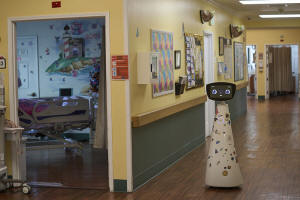A robot programmed to act like a 7-year-old girl works to combat fear
and loneliness in hospitals
[September 19, 2025]
By HALLIE GOLDEN
Days after Meagan Brazil-Sheehan’s 6-year-old son was diagnosed with
leukemia, they were walking down the halls of UMass Memorial Children’s
Medical Center when they ran into Robin the Robot.
“Luca, how are you?” it asked in a high-pitched voice programmed to
sound like a 7-year-old girl. "It’s been awhile.”
Brazil-Sheehan said they had only met the 4-foot-tall (1.2-meter-tall)
robot with a large screen displaying cartoonlike features once before
after they were admitted several days earlier.
“His face lit up," she said about the interaction in June in Worcester,
Massachusetts. "It was so special because she remembered him.”
Robin is an artificial intelligence -powered therapeutic robot programed
to act like a little girl as it provides emotional support at nursing
homes and hospital pediatric units while helping combat staffing
shortages. Five years after launching in the U.S., it has become a
familiar face in 30 health care facilities in California, Massachusetts,
New York and Indiana.
“Nurses and medical staff are really overworked, under a lot of
pressure, and unfortunately, a lot of times they don’t have capacity to
provide engagement and connection to patients,” said Karen Khachikyan,
CEO of Expper Technologies, which developed the robot. “Robin helps to
alleviate that part from them.”
As AI increasingly becomes a part of daily life, it's found a foothold
in medical care — providing everything from note-taking during exams to
electronic nurses. While heralded by some for the efficiency it brings,
others worry about its impact on patient care.
Robin is about 30% autonomous, while a team of operators working
remotely controls the rest under the watchful eyes of clinical staff.
Khachikyan said that with each interaction, they’re able to collect more
data — while still complying with the Health Insurance Portability and
Accountability Act, or HIPAA — and get closer to it being able to
function independently.
“Imagine a pure emotional intelligence like WALL-E. We’re trying to
create that,” he said, referencing the 2008 animated film.

Making its rounds
On a recent Friday, a staff member at HealthBridge Children’s Hospital
in Orange County, California, read off a list of patients she needed
Robin to visit, along with the amount of time to spend with each one.
The robot with a sleek white triangle-shaped frame that Khachikyan said
was designed for hugging, rolled into a room with a teenager injured in
a car accident. The robot played what it described as his favorite song
— “No Fear” by DeJ Loaf — and he danced along. In the hallway, Robin
cracked up a young child held by her mother when it put on a series of
silly glasses and a big red nose. In another room, the robot played a
simplified version of tic-tac-toe with a patient.
Samantha da Silva, speech language pathologist at the hospital, said
patients light up when Robin comes into their room and not only
remembers their names but their favorite music.
“She brings joy to everyone,” da Silva said. “She walks down the halls,
everyone loves to chat with her, say hello.”
Robin mirrors the emotions of the person it is talking with, explained
Khachikyan. If the patient is laughing then the robot laughs along, but
if they're sharing something difficult, its face reflects sadness and
empathy.
In nursing homes, Robin plays memory games with people suffering from
dementia, takes them through breathing exercises on difficult days and
offers them a form of companionship that resembles a grandchild with a
grandparent.
[to top of second column]
|

Robin the Robot, developed by Expper Technologies, visits patients'
rooms at the HealthBridge Orange Specialty Pediatric Hospital in
Orange, Calif., on Friday, Sept. 12, 2025. (AP Photo/Damian
Dovarganes)
 Khachikyan recalled a moment last
year at a facility in Los Angeles where a woman was having a panic
attack and asked specifically for the robot. Robin played songs by
her favorite musician and videos of her favorite animal — Elvis
Presley and puppies — until she had calmed down.
But with the Association of American Medical Colleges projecting
that the U.S. will face a shortage of up to 86,000 physicians in the
next 11 years, Khachikyan’s vision for Robin goes far beyond this
type of support.
He said they’re working to make the robot able to measure patients’
vitals and check to see how they’re doing and then send that
information to their medical team. Longer term plans include
designing Robin to help elderly patients change their clothes and go
to the bathroom.
“Our goal is to design the next evolution of Robin; that Robin will
take more and more responsibilities and become even more essential
part of care delivery,” Khachikyan said.
He clarified that it’s not about replacing health care workers but
about filling in the gaps in the workforce.
At UMass, the robot is very much a part of a team of support for
patients. When Luca needed an IV after not getting one in a while,
Micaela Cotas, a certified child life specialist came in with the
robot and showed him an IV and what was about to happen, and then
Robin played a cartoon of it getting an IV put in.
“It just kind of helps show that Robin has gone through those
procedures as well, just like a peer," Cotas said.
Finding its niche
Robin was developed by Khachikyan while he was getting his Ph.D. He
said growing up in a single-parent household in Armenia had been
lonely, so years later he wanted to build a type of robot that could
act as a person’s friend.
Developers tested it in a variety of industries before an investor
suggested that pediatric hospitals would be a good fit because of
the stress and loneliness children often feel.
“That was kind of an aha moment,” he said. “We decided, OK let’s try
it.”
They had success introducing it at a pediatric hospital in Armenia
and by 2020 launched a pilot program at UCLA Mattel Children’s
Hospital.
Since Robin was created, its personality and character have changed
significantly based on the responses from people it interacts with.
Khachikyan gave the example of Robin’s answer to the question: “What
is your favorite animal.” Initially they tried having the robot
respond with dog. They also tried cat. But when they tried chicken,
the children cracked up. So they stuck with it.
“We created Robin’s personality by really taking users into the
equation,” he said. “So we often say that Robin was designed by
users.”
___
Associated Press journalist Damian Dovarganes contributed to this
report.
All contents © copyright 2025 Associated Press. All rights reserved
 |